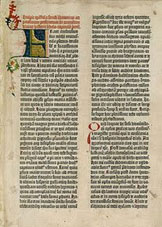 According to traditional dating, on September 30, 1452, Johann Gutenberg’s began printing his Bible which became the first book to be published in volume. The Bible, known as the 42-line Bible because there were 42 lines on each page, was very large consisting of 1280 pages. The Latin words were printed in black ink and then an illustrator added colorful designs in the margin. Two hundred copies of the two-volume Gutenberg Bible were printed, a small number of which were printed on vellum. 48 copies of this bible are known to still exist today.
According to traditional dating, on September 30, 1452, Johann Gutenberg’s began printing his Bible which became the first book to be published in volume. The Bible, known as the 42-line Bible because there were 42 lines on each page, was very large consisting of 1280 pages. The Latin words were printed in black ink and then an illustrator added colorful designs in the margin. Two hundred copies of the two-volume Gutenberg Bible were printed, a small number of which were printed on vellum. 48 copies of this bible are known to still exist today.
The Gutenberg press had movable letters of various sizes and shapes that could be put together to produce uniform lines of printing. The press was developed on the same technology as the screw-type wine presses used in the Rhine Valley. It was a hand press, in which ink was rolled over the raised surfaces of moveable hand-set block letters held within a wooden form and the form was then pressed against a sheet of paper
 The invention was a huge improvement over wood-block printing and handwritten books. The price of printed materials was dramatically decreased and allowed the materials to be available to the masses. Printing presses began to appear throughout Europe. Despite Gutenberg’s efforts to keep his process a secret, by 1500 over 2500 European cities had presses. The written world was now readily available for the masses. The printing press made information much more easy to obtain and helped for advances in many fields including science, art and religion.
The invention was a huge improvement over wood-block printing and handwritten books. The price of printed materials was dramatically decreased and allowed the materials to be available to the masses. Printing presses began to appear throughout Europe. Despite Gutenberg’s efforts to keep his process a secret, by 1500 over 2500 European cities had presses. The written world was now readily available for the masses. The printing press made information much more easy to obtain and helped for advances in many fields including science, art and religion.
